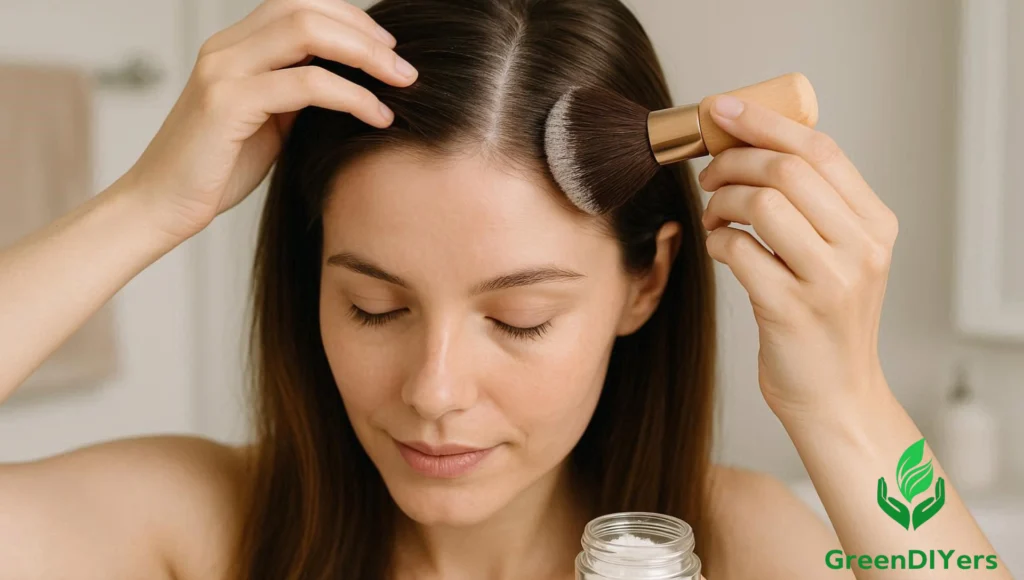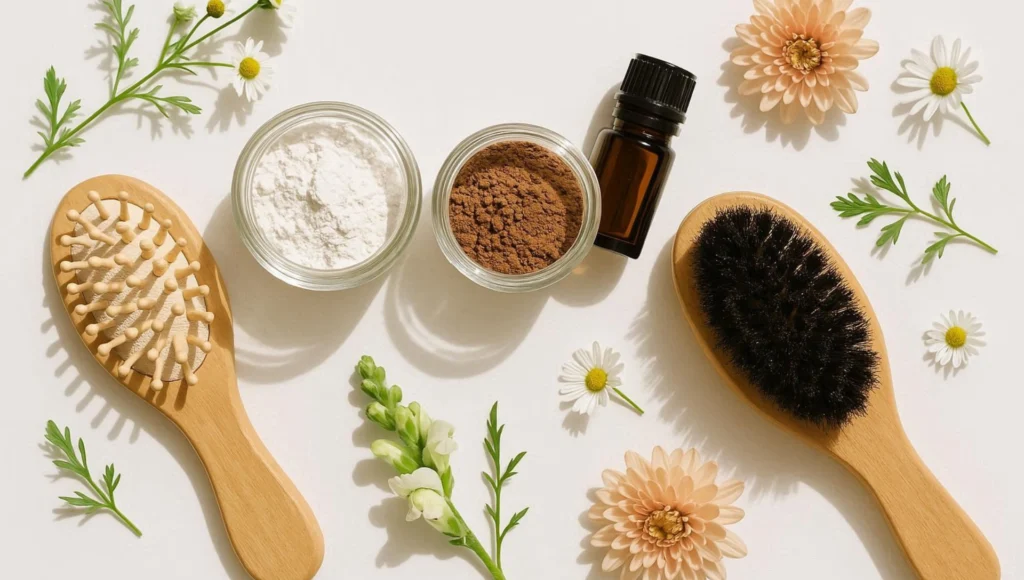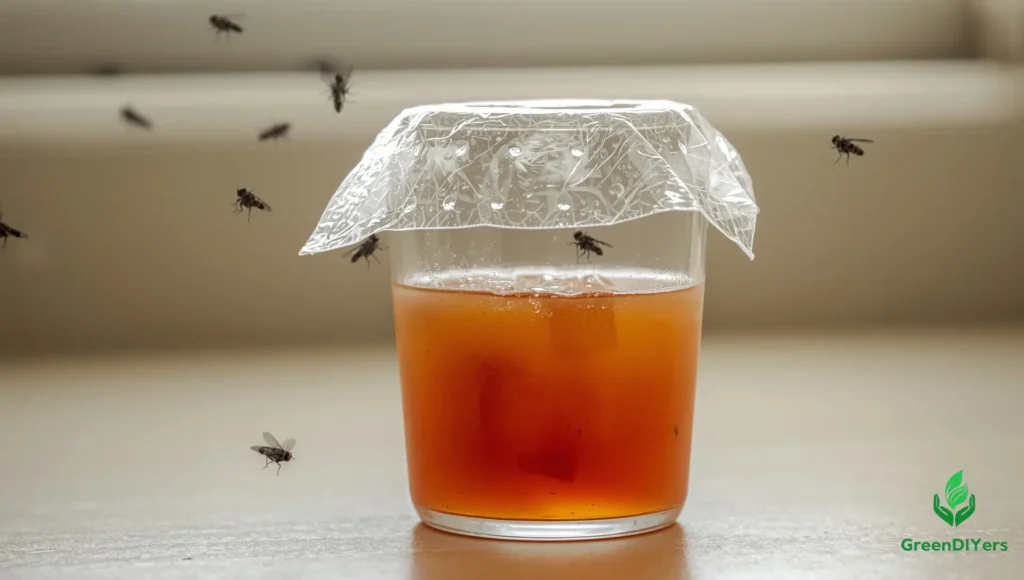We’ve all been there – running late for work with greasy hair, reaching for that expensive dry shampoo only to find it leaves a chalky white residue or triggers scalp irritation. Commercial dry shampoos often contain harsh chemicals, cost a fortune, and come wrapped in environmentally unfriendly packaging. What if I told you there’s a better way?
Enter DIY dry shampoo – your ticket to fresh, voluminous hair without the hefty price tag or questionable ingredients. In this comprehensive guide, you’ll discover multiple foolproof recipes tailored to every hair type and color, learn about ingredient properties and benefits, master professional application techniques, and troubleshoot common issues like a pro.
As someone who’s been crafting natural beauty solutions for years, I’m excited to share everything I’ve learned about creating the perfect homemade dry shampoo that actually works.
Table of Contents
Why Choose Homemade Dry Shampoo?
Health & Safety First
Commercial dry shampoos often contain concerning ingredients like talc, parabens, phthalates, and synthetic fragrances. These chemicals can irritate sensitive scalps and potentially disrupt your body’s natural balance. DIY dry shampoo uses simple, natural ingredients you can pronounce and trust.
Incredible Cost-Effectiveness
Let’s talk numbers. A single bottle of premium dry shampoo costs $15-25 and lasts about a month. The ingredients for homemade versions cost under $10 and can make dozens of batches – that’s savings of over 80%!
Environmental Friendliness
By making your own, you eliminate aerosol cans and plastic packaging waste. Store your diy dry shampoo in reusable glass containers and feel good about reducing your environmental footprint.
Unmatched Customization
This is where homemade truly shines. You can adjust formulas for your specific hair color, type, and scent preferences. Oily roots? Sensitive scalp? Auburn hair? There’s a perfect recipe waiting for you.
The Essential Ingredients: Your DIY Toolkit
Absorbents (The Foundation)
Arrowroot Powder The gold standard for DIY dry shampoo, arrowroot powder is incredibly fine and absorbs oil without feeling gritty. It’s perfect for all hair colors and types, though it can be slightly more expensive than alternatives.
Cornstarch Budget-friendly and effective, cornstarch works wonderfully for most people. Choose non-GMO varieties when possible, and note that it may feel slightly heavier than arrowroot.
Kaolin Clay (White Cosmetic Clay) This powerhouse ingredient not only absorbs excess oil but also detoxifies the scalp and adds volume. It’s particularly beneficial for those with oily or problematic scalps.
Baking Soda While effective for oil absorption, use sparingly! Baking soda can be drying and irritating for some people. Never use more than 1 tablespoon per cup of base ingredients.
Oat Flour (Colloidal Oatmeal) Perfect for sensitive scalps, oat flour provides gentle absorption while soothing irritation. Make your own by grinding old-fashioned oats in a coffee grinder.
Natural Colorants
Unsweetened Cocoa Powder Ideal for brown hair, cocoa powder blends seamlessly while adding a subtle chocolate scent. Use pure, unsweetened varieties only.
Activated Charcoal For very dark or black hair, activated charcoal works wonders, but use extremely tiny amounts – it’s potent and can stain if overused.
Cinnamon Powder Perfect for auburn or reddish hair, cinnamon adds warmth and a pleasant scent. Always patch test first, as it can irritate sensitive scalps.
Essential Oils (Optional Enhancement)
Add 2-3 drops per 1/4 cup of base mixture:
- Lavender: Calming and universally loved
- Peppermint: Refreshing and great for oily scalps
- Rosemary: Promotes hair health with an herbaceous scent
- Tea Tree: Antifungal properties, excellent for problem scalps
Foolproof Recipes for Every Need
The Starter Recipe (Perfect for Beginners)
Ingredients:
- 1/4 cup arrowroot powder
- 1/4 cup cornstarch
Simply mix together and store in an airtight container. This basic diy dry shampoo works beautifully for light to medium hair colors.

Recipes by Hair Color
Light Blonde/Silver Hair
- 1/2 cup arrowroot powder
- 2 drops lavender essential oil
Red/Auburn Hair
- 1/4 cup arrowroot powder
- 1/4 cup cornstarch
- 1 teaspoon cinnamon powder
Medium to Dark Brown Hair
- 1/4 cup arrowroot powder
- 1/4 cup cornstarch
- 1-2 tablespoons unsweetened cocoa powder
Black Hair
- 1/4 cup arrowroot powder
- 1/4 cup cornstarch
- 1/4 teaspoon activated charcoal (start small!)
Specialized Formulas
Ultra Oily Scalp Formula
- 1/4 cup arrowroot powder
- 1/4 cup kaolin clay
- 2 drops tea tree oil
Sensitive Scalp Formula
- 1/2 cup oat flour
- 2 drops chamomile essential oil
Volumizing Formula for Fine Hair
- 1/4 cup arrowroot powder
- 2 tablespoons kaolin clay
- 2 drops peppermint oil
Mastering the Application
Essential Tools
The right applicator makes all the difference. Try:
- Kabuki makeup brush: Provides controlled, even distribution
- Old spice shaker: Great for targeting specific areas
- Powder puff: Gentle application for sensitive scalps
Step-by-Step Application
- Section your hair into manageable parts, focusing on the oiliest areas (usually the crown and hairline).
- Apply sparingly directly to the roots, not the scalp itself. Less is more with DIY dry shampoo.
- Let it sit for 2-3 minutes to absorb maximum oil.
- Massage gently with fingertips to work the powder into hair.
- Brush thoroughly with a natural bristle brush to distribute product and remove excess.
Pro Tip: Apply your diy dry shampoo before bed for maximum oil absorption overnight!
Troubleshooting Common Issues
The Dreaded White Cast
Cause: Using too much product or wrong color match Solution: Use less powder, blend more thoroughly, or adjust your color formula
Hair Still Feels Oily
Cause: Insufficient product or poor application technique Solution: Use slightly more product, ensure you’re hitting all oily areas, try a different formula
Scalp Irritation
Cause: Ingredient sensitivity or overuse Solution: Patch test new ingredients, reduce frequency, switch to gentler formulas like oat flour
Gritty or Stiff Hair
Cause: Too much product or inadequate brushing Solution: Use less powder, brush more thoroughly, ensure complete distribution
Storage and Shelf Life
Store your DIY dry shampoo in airtight containers away from humidity and direct sunlight. Glass jars with tight-fitting lids work perfectly. Most formulas last 6-12 months when stored properly.
Signs to replace your batch include clumping, off odors, or changes in texture – though these are rare with properly stored products.
Advanced Pro Tips
Pre-Application Strategy
Apply a small amount to freshly washed hair to create a barrier against future oil buildup.
Volume Boosting Technique
Apply to mid-lengths and ends, not just roots, for all-over body and texture.
Travel Solutions
Pre-fill small containers or repurpose old makeup compacts for portable diy dry shampoo.
Frequently Asked Questions
Is homemade dry shampoo bad for your hair? No! When used properly, DIY dry shampoo is gentler than commercial versions since you control every ingredient.
Can you use just cornstarch as dry shampoo? Yes, plain cornstarch works in a pinch, though it may feel heavier and look more obvious than blended formulas.
How often should I use homemade dry shampoo? 2-3 times per week maximum. Overuse can lead to buildup and scalp issues.
Is it safe for color-treated hair? Absolutely! DIY dry shampoo won’t strip or fade hair color like some harsh commercial formulas.
Does DIY dry shampoo cause hair loss? No, when used correctly. Always brush thoroughly to prevent buildup that could potentially clog follicles.
Your Journey to Better Hair Starts Now
Creating your own DIY dry shampoo isn’t just about saving money – it’s about taking control of what you put on your body and finding formulas that work perfectly for your unique needs. Start with the basic recipe and experiment until you find your holy grail blend.
The beauty of homemade dry shampoo lies in its simplicity and effectiveness. With just a few natural ingredients, you can create a product that rivals expensive store-bought versions while knowing exactly what’s going into your hair.
Ready to ditch those overpriced, chemical-laden commercial dry shampoos? Gather your ingredients and start mixing – your hair (and wallet) will thank you!



